Achieving a state of accurate, consistent, and timely financial reporting is not without its challenges. Certainly, for professional services firms with fluctuating demand, new market opportunities, and Paycheck Protection Program (PPP) reporting needs, financial reporting is vastly more complex and often includes a “need it yesterday” deadline.
Tanya Yakhnis (CFO of Tandem Family of Companies) and Erik Hannemann (CFO of Southern Sports Medicine Partners) recently joined Sage Intacct Professional Services industry expert, Brian Siefkes, to discuss how to interconnect teams, processes, and technology to create the optimum infrastructure for financial reporting.
Three core areas Professional Services firms should focus on when building their foundation to scale are teams, processes, and tools. Let’s look closer at each of these areas.
Teams
Your goal is to build the finance and accounting dream team that increases valuable output. Combining junior members seeking to grow with senior members happy to coach helps your team maintain a level of cooperation and visibility. This fosters an environment in which new ideas are welcomed and can be discussed, and where business process improvements flourish.
Your team must consistently earn your trust and the trust of your internal and external audiences, from customers and board members, to your executives. This trust is often dependent upon the accuracy, consistency and timeliness of the financial reporting provided. You need a high-performance team that can work autonomously with the tools they need so you can do your work and be a strategic advisor.
“Aim for diversity even in skill sets – some detail-oriented, others more process-oriented,” advises Hannemann. You want a mix with some employees strong on GAAP, and others who are curious about data.
You have to think about your resource needs for the future. It’s a tight labor market and planning ahead will help you adjust to labor conditions as they unfold. Bottomline, you want a culture of accountability and growth and you need to provide the tools to make both happen.

Processes
Accounting is process-oriented, as such you need common principles governing your processes and changes. Streamlining and automating processes will help you achieve your productivity and timeliness objectives. The accuracy improvement happens when automation reduces data entry with data flowing from back office and front office operations into a single integrated reporting solution. Project accounting capabilities will allow your teams to make data-grounded decisions on a project level quicker, helping you protect project margins.
Yakhnis states, “If cash is an issue or something that’s top of mind for your organization, you can create a dashboard. What can you show them daily, weekly, and biweekly in real-time to help remove the ambiguity and provide a continuous flow of information so that there are no surprises? Again, the goal is that everyone knows what’s happening and we’re focusing our time where we need to focus our time.”
As you create your best practices and erect workflows, you should plan to regularly reevaluate them and make them part of your continuous business improvement plan. You need to consider how to build your compliance and reporting framework and ensure it is scalable as your company grows. Your accounting or financial management system should optimize, standardize and automate processes allowing you to take advantage of standardization and the speed consistency that come with it.
“The principles will always apply. The ask is, is the process we have now repeatable and scalable? And what we’ve learned is that as your business grows, you have to change the process because what works at $10 million in revenue, most likely is not going to work once the business has doubled. You have to reassess the process and that’s okay,” suggests Hannemann, “write processes and tools to be ahead of potential challenges. And to ensure, as Tanya said, there are no surprises.”
Tools
As finance continues to evolve and the CFO works in a more operational environment, you need tools that foster collaboration and automate tasks. This is where your long-term planning really comes into play. “You need to know your end goal – understand what you need from a software point of view five years from now, and then make the implementation now,” Hannemann advises. “These larger infrastructure projects will pay off down the road.”
Yakhnis states, “it’s important you can integrate with your ERP and that it can digest all of the data.” Once you consolidate financial data and operational data, you need to be able to capture and tag the data and add dimensions that work for your unique business needs so you can create informative reports, slice and dice the data in a variety of ways, and have those productive discussions. A time-saving financial management solution that helps teams close the books quicker and generates well-formatted reports faster helps you “get your time spent where it matters most.”
By investing in technology early on, you’ll have a longer period of historical data from which to measure your KPIs and will have established a way to track non-financial data. You will have automated many workflows and have new processes in place that utilize time savings netted from eliminating manual spreadsheet steps. From project financials to client profitability and overall company performance, you will have a means of measuring and adjusting business drivers to achieve business outcomes.

Lastly, you need all the data in one place for one source of truth of real-time data shared across teams. Data accuracy, integrity, and timeliness increase trust and make collaborating easier. Yakhnis mentioned the benefits of saving time by having integrated reporting that allows you to customize and templatize reports.
With strong teams, processes and tools in place, professional services firms can shift time and focus from spreadsheet and formula management to value-add, process improvement initiatives.
This post was originally published on Sage.com


